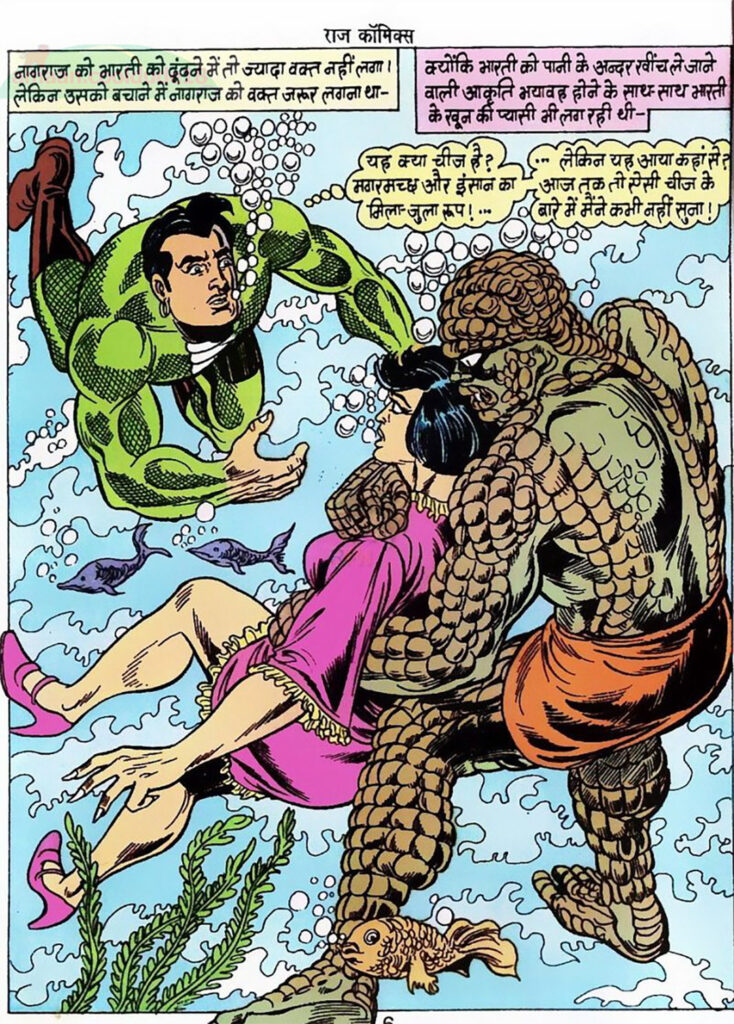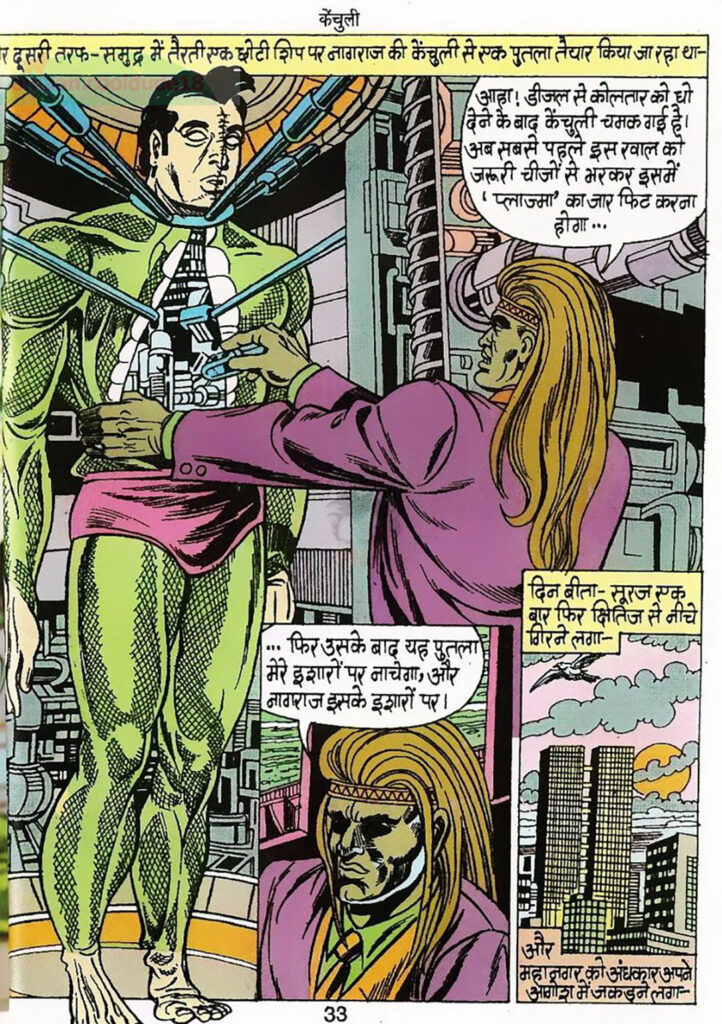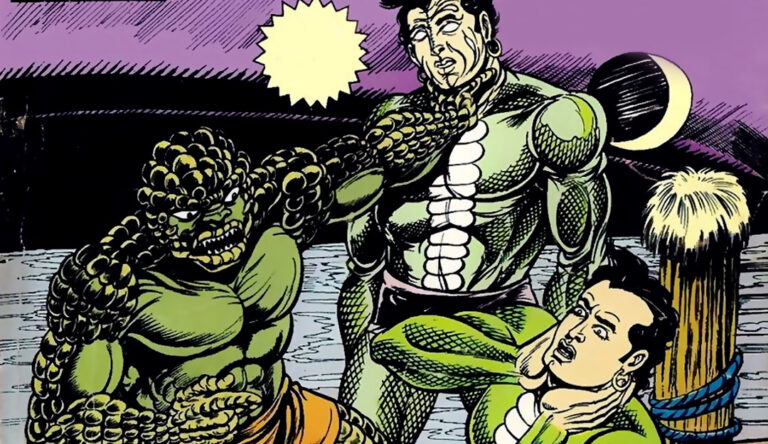“Kenchuli”, published by Raj Comics, shows one such adventure of Nagraj, where he is struggling not only with external enemies but also with a part of his own existence. It is made clear at the very beginning of the story that superheroes like Nagraj and Dhruv can defeat their external enemies, like Miss Killer, Nagpasha, and Nagmani, but when their own personality becomes their enemy, they can do nothing. It’s an interesting concept that gives the story a deep and philosophical twist.
This comic appears to be connected to the events of the previous stories “Poison”, “Treasure”, and “Crime King”. In the story, Nagraj wanders with his old loyal companion Vedacharya and Bharati to get information about the treasures of his clan. The great astrologer Vedacharya had handed over the treasure of Nagraj’s clan to him, but he had no idea about the first 40–50 years of Nagraj’s life. Based on his calculations, Vedacharya went on a journey to a secret sea near Nagadweep, where, due to the attack of Tantrik Vishdhar, he became unconscious and reached Mahatma Kaaldoot of Nagadweep.
In this part of the story, Nagraj and Bharati go to Rajnagar port in search of Vedacharya to meet the captain of the ship on which Vedacharya was last seen. Captain Sharma gives them the sad news of Vedacharya’s disappearance. He tells them that Vedacharya took a small boat from the ship without permission and landed in the middle of the sea, and the area is full of sharks and rocky reefs, where survival is almost impossible. Hearing this, Bharati breaks down in sadness, but a ray of hope shines in Nagraj’s eyes. When the captain marks that place on the map, Nagraj realizes that Vedacharya has landed at a short distance from Nagadweep. Nagraj consoles Bharati that they will soon find Vedacharya.

But this happiness proves to be fleeting. Suddenly, a sinister crocodile-human hybrid figure drags Bharati underwater. Nagraj immediately leaves his Raj form, takes the form of Nagraj, and jumps into the water to save Bharati. Underwater, Nagraj realizes that his poison hiss will be ineffective here, and he must use his physical strength. He uses the water snakes present in his body to attack the creature, but it eats his snakes. Nagraj is surprised by the power of that creature. He manages to save Bharati and brings her to the surface. Nagraj learns that Bharati has to be taken to the hospital immediately, but finds himself trapped in the creature’s snare.
Nagraj seeks a strong weapon to fight the creature and sees the chain of a ship’s anchor. He traps the creature in the chain and heads to the hospital so that Bharati can be saved.
Nagraj vs. Nagraj
The name of that hybrid creature is Magraha, and it has been created by a crooked scientist named Julu. Julu’s ultimate goal is to make Nagraj his slave, and for this he has made a satanic plan. He wants to control the real Nagraj’s body through a replica earthworm (Knauul).
The central conflict of the story originates here. Nagraj soon realizes that he cannot cause any damage to his clone. The pain of every injury on the clone is directly felt on Nagraj’s body. This unique situation makes him powerless and helpless in front of his own reflection. He cannot attack the enemy who is a part of him. This duel turns the story into a psychological thriller, where Nagraj’s physical strength is of no use to him. Julu takes full advantage of this weakness and sends Kenchuli in the form of Nagraj to spread terror in the city so that the image of the real Nagraj is tarnished and the law considers him its enemy.
Analysis of Major Characters
Nagraj: The character of Nagraj acquires unprecedented depth in this story. He emerges from his unstoppable image as a character who feels pain, who is helpless, and who is going through mental anguish. Being beaten at the hands of his own clone, suffering pain, and being forced to flee — all this deeply impinges on his self-esteem. In the end, deciding to destroy a part of himself is a true test of his mental toughness and heroism.

Julu: Julu is a memorable villain because his motive is not to rule the world like ordinary villains, but to establish complete control over a powerful personality like Nagraj. He is intelligent, visionary, and has a deep understanding of Nagraj’s physical structure. He transforms Nagraj’s strength into his weakness and plays a psychological game that almost breaks Nagraj.
Faceless: When Nagraj is at his weakest moments, the arrival of ‘Faceless’ becomes a ray of hope. He is a mysterious masked man whose intentions are unclear, but he emerges as an important ally of Nagraj. He not only helps Nagraj physically but also prepares him mentally to fight this impossible battle.
Bharati: Bharati is an emotional focal point in this story. The main conflict of the story begins with the attack on her. Her safety remains a priority for Nagraj, which further increases the emotional stakes in the story.
Artistic Excellence and Screenplay
Anupam Sinha has played the dual role of writer and illustrator in these comics and has demonstrated excellence in both.
Screenplay: The pace of the story is very tight. A mix of mystery, action, drama, and psychological stress keeps readers engaged till the end. The dialogues are sharp and impressive, especially the one that establishes the central idea of the story: “The idea of protecting your clone instead of killing it, Nagraj! Because every injury that falls on it will fall on your own body.”
Illustration: Sinha’s art is the life of this story. Action scenes, such as the underwater conflict and the fight in a hospital building, are extremely lively and dynamic. Magraha’s design evokes fear and hatred. The expressions of pain, anger, and helplessness on Nagraj’s face have been depicted very skillfully. Vitthal Kamble’s inking and Sunil Pandey’s colors have made the serious atmosphere of the story more effective.
Philosophical Aspect of ‘Kenchuli’
Kenchuli raises not just one but many deep philosophical questions.
Nagraj’s story Kenchuli touches on many deep themes. It teaches us that our past, which we leave behind, often tries to destroy our present by returning in a distorted form. Nagraj fighting with his own clone is a symbol of self-destruction, which shows that our biggest fight is not with external forces, but with our own weaknesses and past. This story also raises questions about true power — is power an unlimited physical force, or the mental ability to make the right decisions while remaining calm in adverse situations? In the end, Nagraj wins not by his physical strength, but by his mental toughness.
Conclusion
Nagraj – Kenchuli is a milestone in the history of Indian comics. It is a bold and mature story that was far ahead of its time. It elevates Nagraj from an ordinary superhero to a tragic hero who has to deal with his own existence. Its tight script, memorable villains, brilliant art, and deep philosophical themes make it relevant and readable even today. This comic is not just for Nagraj fans, but for everyone who is looking for a good, thought-provoking, and emotionally impactful story. Kenchuli is proof of how powerful and complex stories the medium of comics is capable of telling.
